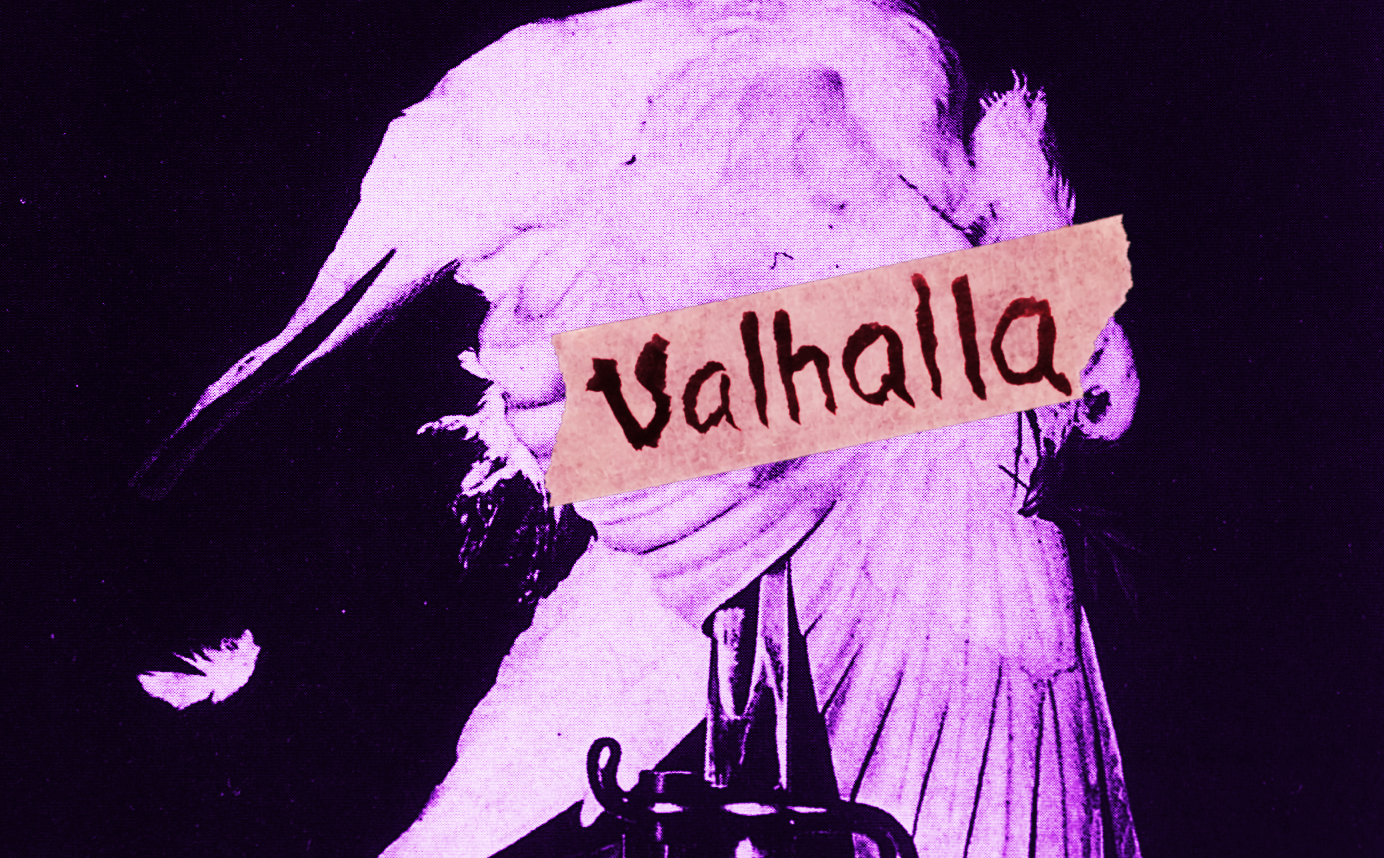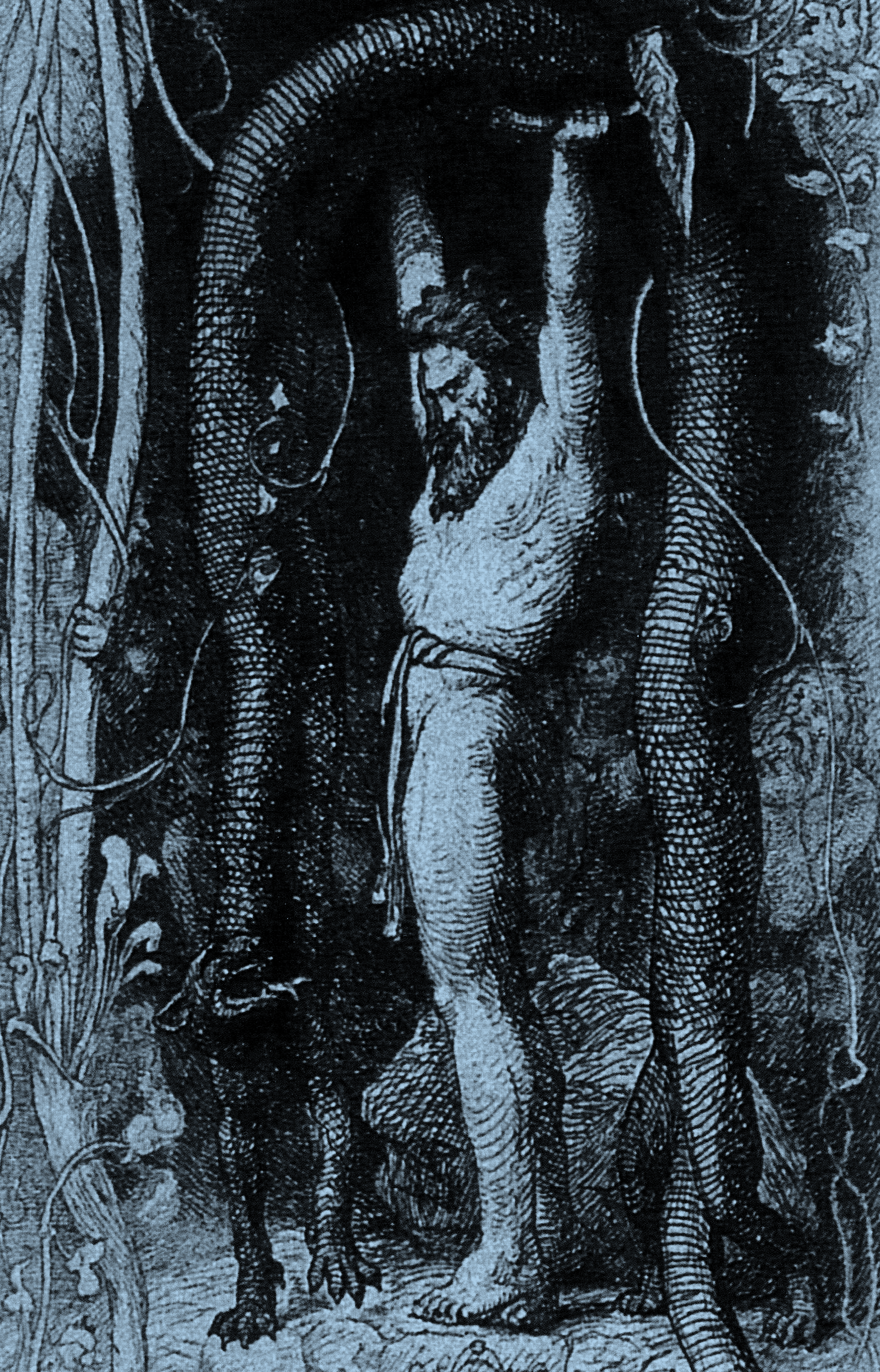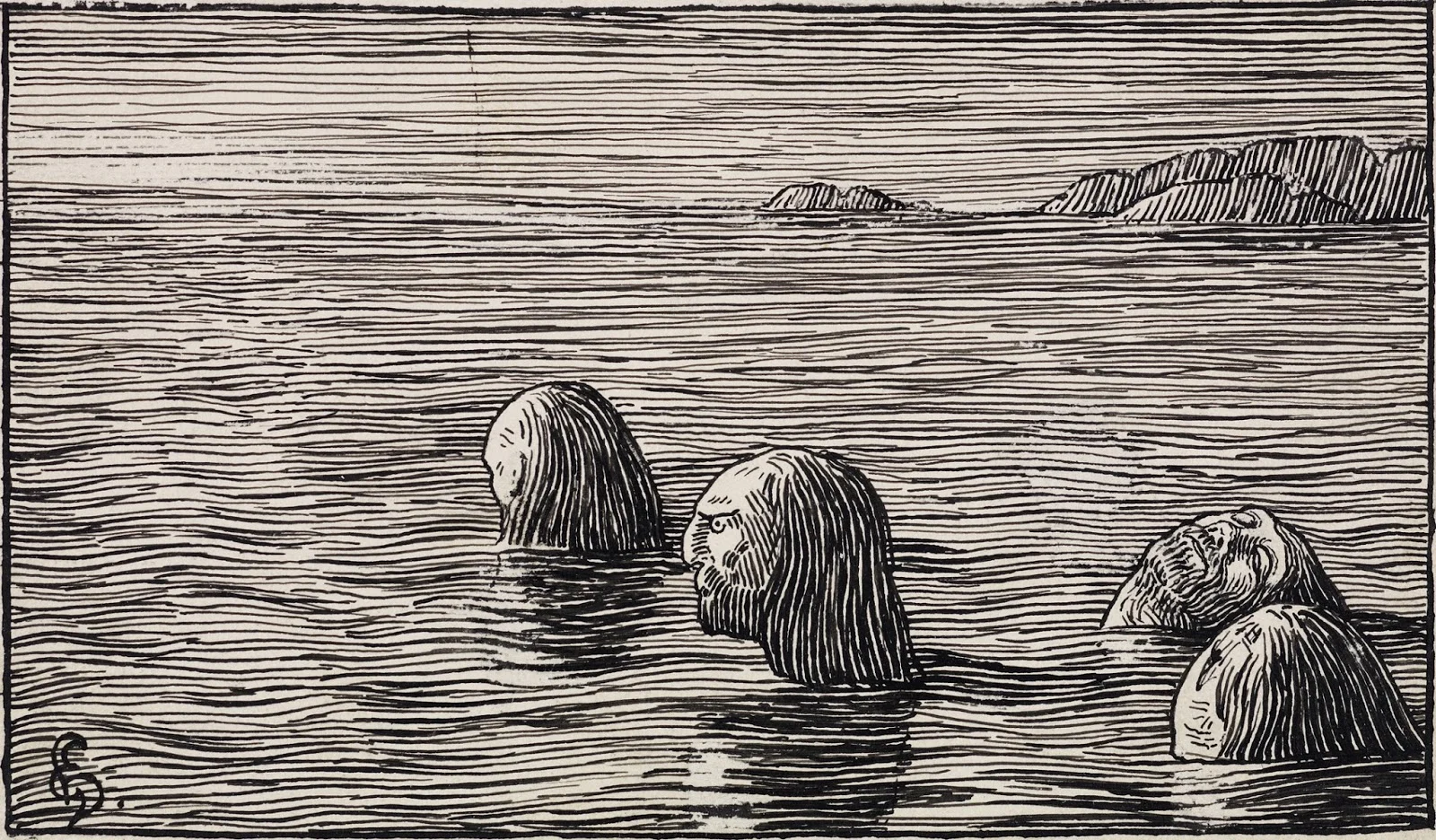This is not a clown car joke. Neither is it a rhetorical question. This very subject is actually addressed in a particular stanza of the eddic lay Grímnismál, wedged in between other nuggets of cosmic knowledge. Never heard of it? Let me give you a quick run down.
Grímnismál - The Sayings of the Concealed One
Our story begins when Odin and his wife, the all wise goddess Frigg, were sitting in the high seat Hlíðskjálf, from whence they could observe the entire world. They noticed the brothers Agnar and Geirrǫd, whom they had kept in foster care when they were children. Look, says Odin; Agnar hasn't amounted to anything at all - he spends all his days boning an ogress! Sad. But look at my boy Geirrǫd here! He's a king, he's got his own country and everything! Now Frigg cast eyes on her husband, and told him that hardly had there ever lived a king more cruel: Geirrǫd is the worst host, she said, and he tortures his guests if he thinks the hall is too crowded. That's a damnable lie, Odin snapped back, rolling his eye, but Frigg insisted it was true. Then husband and wife decided to settle it with a wager to put Geirrǫd's hospitality to the test. Odin went to chieftain's hall disguised as a drifter and called himself Grímnir - the concealed one. But Frigg had sent her servant ahead to rig the game against him, and told the king to be weary of the incoming stranger.
As you can imagine, this only served to whet Geirrǫd's curiosity about the old hobo, but Grímnir revealed nothing but his name when asked. Soon enough the host's patience was exhausted. No more mister nice guy, he might have said, as he made a shibari display of Grímnir between two great fires. For eight full nights he was roasted, but still he revealed nothing. Then Geirrǫd's son, called Agnar after his uncle, thought it was too terrible to see an old man tormented like this. He filled a horn with drink and offered it to Grímnir, whose cape was now beginning to catch fire. The captive chugged down the horn's contents, and immediately started spilling some cosmic beans.
This is where the prologue ends and the actual poem Grímnismál starts, with Odin thanking the boy and giving a lengthy description of the structure of the universe, as well as various past and future events. He talks about the various estates of gods and superhuman entities, of divine animals, and how the various sectors of the cosmos connect through a system of rivers emanating from the cosmic spring Hvergelmir. He ends with a list of his miscellaneous identities, revealing himself as none other than the god Odin. Oh shi- Geirrǫd exclaimed as he got up from his chair, leaping to free the prisoner, but instead he tripped and fell on his sword - killing himself. It is said that Agnar lived a long and prosperous life.
The magic of numbers
But long before this, in stanza 23, Odin-Grímnir touches upon the spaciousness of Valhalla, which contains "five hundred and forty doors", and through each there are "eight hundred champions [Einherjar]" who shall pass through them when Ragnarǫk finally comes:
Fimm hundruð dura
ok umb fjórum tǫgum,
svá hygg ek á Valhǫllu vera;
átta hundruð Einherja
ganga senn ór einum durum,
þá er þeir fara við vitni at vega.
Five hundred doors
and then forty more
I think there are in Valhalla;
eight hundred champions
shall walk through each
when they go to battle the wolf.
I love how even Odin struggles to remember what his own house looks like. But what do these numbers really mean, and how many warriors can we actually fit in Valhalla according to this passage? There are two possible answers to this. First of all, the word hundred didn't always stand equal to the number 100 as it does today. In the viking age, as with the middle ages, the Norse number system conventionally thought of a hundred (hundruð) as the sum of twelve times ten. I.e. 120.
This is usually called a long hundred in current English, or alternately a great hundred (Norwegian: storhundre). I first stumbled across this discussion in Andreas Nordberg's influential PhD dissertation called Krigarna i Odins Sal ["The Warriors in Odin's Hall"], where he seems to mention it mostly as a curiosity. A minor detour to his academic road trip of discourse on the aristocratic warrior cult of Odin.
But as I was saying. If the composer of Grímnismál, when saying hundred, actually meant one hundred and twenty in accordance with the oldest convention, then the equation should go like this:
640×960 = 614,400
In other words, Valhalla should be able to fit just about half a million people. That's guests, mind you. I've not taken the waiting and kitchen staff into account, neither have I considered janitors or cleaning ladies. Odin leaves all of that to our imaginations. Never the less it beats the crap out of the Jehovah's Witnesses' measly claim to a full capacity of 144,000 souls in Paradise. However, if for some reason we assume that the author of Grímnismál had our current concept of hundred in mind, that is to say, that one hundred equals 100, then we get a different equation and a far more interesting sum:
540×800 = 432,000
There are a number of reasons why this number is interesting, so keep on reading. First of all we have a similar account of a troop tally in the first lay of Helgi Hundingsbana ("Helgi Hunding's Bane"), in which the hero states there are "twelve hundred trusty men, though in Hátúna ["The High Estate"] twice as many" (stanza 25). Let us do this calculation twice, like we did above, but this time we shall start with the numbers at face value, disregarding our expectation that the author understood "hundred" as the number 120, rather than 100:
1200 + 1200×2 = 3600
A very unassuming number indeed. But let's see what happens when we do it again with the archaic long hundred:
1440 + 1440×2 = 4320
That amounts to exactly 1/100 of the number of champions in Valhalla according to Grímnismál, which we saw could fit as many as 432,000 people! But as we recall, this was only when we used the opposite counting system, disregarding the long hundred altogether. So what does this mean? It could be that both poets intended to reach these numbers, but used differing numerical systems to reach them. But why?
432000, multiplications of three, and the Indo-European connection
If you thought this was trippy, you've got another thing coming. The number 432,000 occurs in another, more famous context, namely Hindu texts: 432,000 is the exact number of solar years in the Kali Yuga, which is the final epoch of the Hindu cosmic cycle before the world destroys itself and a new cycle and golde era begins. The entire cycle, by the way, lasts 4,320,000 years according to the Viṣṇu Purāṇa, which it equates to 12,000 "divine years" (120×100). Puranic literature alleges that the Kali Yuga began roughly 5000 years ago, in the year 3102 BC (corresponding roughly with the aegan bronze age), when the god Krishna left his earthly body, having been shot dead by a stray arrow in a hunting accident. Similarly, the Norse god Baldr was shot dead by the blind god Hǫðr, and this too may be considered a point of no return in Norse mythology, opening the path to Ragnarǫk itself.
Nordberg mentions (on page 230) that scholars have been hard pressed to find a plausible connection between these numerical phenomena. There is no evidence for any continuity between these beliefs back to a common Proto-Indo-European origin, apart from the fact that both may draw from a common Indo-European counting system. As for numbers in Indo-European cultures, that's a fascinating subject in itself.
Any fool that ever cast a quick glance at Norse mythology will be struck by the emphasis put on the number three, as well as its multiplications. Particularly the numbers nine and twelve. Gods and other divine beings often operate in units of three, and mythical events are frequently divided into three phases. The same applies to the number nine, like the cosmological concept of níu heimar – the nine worlds – cryptically alluded to in eddic poetry. In the legendary sagas, berserkers frequently appear in groups of twelve, a peculiar principle they share with outlaws and bandits in later Norwegian ballads and folk tales. It's probably no accident that our poem deals with Grímnir being tortured for eight whole nights: Necessarily, he finds respite on the beginning of the ninth day.
As we've already seen, these numbers may be a feature inherited from a common Indo-European source. The study of numbers in comparative mythology recalls the work of the mythographical scholar Georges Dumézil, who alleged that tripartite socio-religious patterns were characteristic of all Indo-European religions, and consequently the Proto-Indo-European culture itself. This formed the basis for social stratification in Indo-European ideology, with a societal hierarchy of priest-rulers, warriors, and producers. To Dumézil, the trinity of Odin, Thor, and Freyr described by Adam of Bremen at the Temple of Uppsala, generally reflect the same ideas and origins as the Hindu caste system, for example.
While Dumézil might be on to something, his model works best if we choose to cherry pick and simplify our body of evidence. For example, the Hindu caste system operates with four rather than three distinct classes. Any overly rigid application of tripartite theory seems bound to fall apart when faced with the inconsistencies and variations of our evidence. Units of three seem universal, but the contents of these units are unstable. But that is a subject for another time.
































